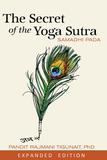Q: What is the Yoga Sutra and why is it so important?
A: The Yoga Sutra of Patanjali lies at the heart of the yoga tradition. This venerable scripture is the alpha and omega of yoga philosophy and practice. Attempting to practice yoga without knowing the Yoga Sutra is like trying to run a country without knowing its constitution.
It is important to understand at the outset that, in the context of this scripture, the word yoga refers to the mind’s ability to know itself and its relationship with the body; to know its relationship with the larger world; and ultimately, to know the inner and eternal reality that existed before we were born, that accompanies us while we are alive, and that continues to exist after we die. In short, the Yoga Sutra is a manual for experiencing our inner divinity and becoming firmly established in it.
These first three sutras—a declaration of the independence of the body, mind, and soul—are the heart of the first chapter.
The text itself consists of 195 sutras (aphorisms) divided into four chapters, or padas (steps). The first chapter, “Samadhi Pada,” the step toward acquiring a still and pristine mind, sets out the prerequisites for discovering our true nature and becoming established in it. This chapter contains 51 sutras. Just as the Declaration of Independence laid the foundation for freedom in the United States, the first three sutras in this text lay the foundation for the freedom conferred by the practice of yoga. These first three sutras—a declaration of the independence of the body, mind, and soul—are the heart of the first chapter, and the first chapter is the heart of the remaining three chapters.
The second chapter, “Sadhana Pada,” the step toward practicing yoga, contains 55 sutras. Here, the vast range of yoga practices is broken down into smaller steps so people with different physical, emotional, and intellectual capacities can choose the specific practices most appropriate for them. The practices described in this chapter have two purposes: to induce samadhi—a perfectly still, pristine state of mind—and to minimize the afflictions that create obstacles in our practice. It is in this chapter that Patanjali lays out the eightfold (ashtanga) path, which has come to be known as raja yoga.

The third chapter, “Vibhuti Pada,” contains 55 sutras. Vibhuti means “awakening of the dormant potentials.” “Vibhuti Pada” is the step toward awakening the limitless potentials that normally lie dormant within us. The assumption is that studying and practicing what has been described in the first two chapters has given us considerable mastery over our body, mind, and senses. This chapter tells us how to turn our pristine, tranquil mind inward and how to focus it on various objects, thereby expanding the scope of our consciousness.
“Kaivalya Pada,” the fourth and final chapter of the Yoga Sutra, contains 34 sutras. Kaivalya means “ultimate freedom.” The practices described in this final chapter focus on attaining freedom from the binding forces of the mind. This chapter also tells us how to safely and productively undertake the practices described in the previous three chapters. Here, Patanjali draws on the principles of ayurveda and the science of mantra to fuel our yoga practices. He tells us how to become healthy, how to secure a long life, how to overcome our subhuman tendencies, and eventually, how to discover the intrinsic divinity hidden in the cave of our heart.
Know your mind and you will know the whole world; master your mind and you will become master of the whole world.
The timeless wisdom contained in the Yoga Sutra takes us directly to the heart of thousands of great masters of the past. This wisdom is simple and straightforward: know your mind and you will know the whole world; master your mind and you will become master of the whole world.
There is no mystery greater than the mystery of the mind, and only a healthy, well-controlled mind can unveil this mystery. The Yoga Sutra acknowledges that the body and mind are equally important. A healthy body is crucial to a healthy mind. The first step in cultivating a healthy mind is to cultivate a mind that is clear and tranquil. This kind of mind enables us to understand what is right and what is wrong, what is healthy and what is unhealthy, what is good and what is bad, and ultimately, what is to be desired and what is to be avoided.

Our ability to acquire a clear, calm, and tranquil mind is compromised by our habit patterns, which dictate our tastes and interests. While Patanjali acknowledges that the mind directs the functions of the body, once the mind has become the prisoner of its own habit patterns, the body begins to create its own rules and laws. In such a situation, a rift opens between the body and the mind, and we find ourselves cut off from the pool of inner intelligence that lies dormant within us—the revealing forces of the mind and the healing forces of the body. To overcome this problem, Patanjali offers a system of inner awakening—a methodology that empowers us to tap into the wisdom of our body, awaken its dormant forces, create a bridge between the body and the mind, and reach the inner divinity that resides in the lotus of our heart. That is the gift of the Yoga Sutra.

